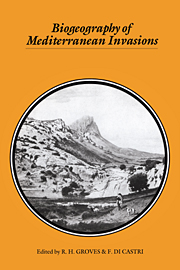Book contents
- Frontmatter
- Contents
- List of contributors
- Preface
- Part I Introduction
- Part II Historical background
- Part III Biogeography of taxa
- 7 Invasive plants of the Mediterranean Basin
- 8 Invasive vascular plants of California
- 9 Introduction of plants into the mediterranean-type climate area of Chile
- 10 Introduced plants of the fynbos biome of South Africa
- 11 Invasive plants of southern Australia
- 12 Life cycles of some Mediterranean invasive plants
- 13 Invasion processes as related to succession and disturbance
- 14 Is fire an agent favouring plant invasions?
- 15 Plant invasion and soil seed banks: control by water and nutrients
- 16 Invasion by annual brome grasses: a case study challenging the homoclime approach to invasions
- 17 Patterns of Pleistocene turnover, current distribution and speciation among Mediterranean mammals
- 18 Introduced mammals in California
- 19 Ecology of a successful invader: the European rabbit in central Chile
- 20 Mammals introduced to the mediterranean region of South Africa
- 21 Mammals introduced to southern Australia
- 22 Invasions and range modifications of birds in the Mediterranean Basin
- 23 Invasions in the mediterranean avifaunas of California and Chile
- 24 Birds introduced to the fynbos biome of South Africa
- 25 Species of introduced birds in mediterranean Australia
- Part IV Applied aspects of mediterranean invasions
- Part V Overview
- Index of scientific names
- Subject index
21 - Mammals introduced to southern Australia
Published online by Cambridge University Press: 02 December 2009
- Frontmatter
- Contents
- List of contributors
- Preface
- Part I Introduction
- Part II Historical background
- Part III Biogeography of taxa
- 7 Invasive plants of the Mediterranean Basin
- 8 Invasive vascular plants of California
- 9 Introduction of plants into the mediterranean-type climate area of Chile
- 10 Introduced plants of the fynbos biome of South Africa
- 11 Invasive plants of southern Australia
- 12 Life cycles of some Mediterranean invasive plants
- 13 Invasion processes as related to succession and disturbance
- 14 Is fire an agent favouring plant invasions?
- 15 Plant invasion and soil seed banks: control by water and nutrients
- 16 Invasion by annual brome grasses: a case study challenging the homoclime approach to invasions
- 17 Patterns of Pleistocene turnover, current distribution and speciation among Mediterranean mammals
- 18 Introduced mammals in California
- 19 Ecology of a successful invader: the European rabbit in central Chile
- 20 Mammals introduced to the mediterranean region of South Africa
- 21 Mammals introduced to southern Australia
- 22 Invasions and range modifications of birds in the Mediterranean Basin
- 23 Invasions in the mediterranean avifaunas of California and Chile
- 24 Birds introduced to the fynbos biome of South Africa
- 25 Species of introduced birds in mediterranean Australia
- Part IV Applied aspects of mediterranean invasions
- Part V Overview
- Index of scientific names
- Subject index
Summary
Many mammals have been introduced to southern Australia in the 200 years of European settlement of the region. During one of the most active periods for animal introduction, between 1860 and 1880, more than 60 species of vertebrates were released into the Australian environment. More were to follow later with the advent of a broader immigration policy and the development of aquaculture and aviculture. Some of these introductions failed, whilst others prospered. Some introduced vertebrates are now problems in northern Australia. The majority of the 47 species of mammals brought into Australia (Myers, 1986) were introduced, however, into southern, mediterranean-climate regions (Table 21.1).
Of the larger pest species, only the goat (Capra hircus), pig (Sus scrofa) and water buffalo (Bubalus bubalis) have been studied in detail, mainly in relation to regional pest situations (see e.g. Henzell & McCloud, 1984, on goats; Taylor & Friend, 1984, on water buffalo). Several smaller species of pest mammal have been the subjects of intensive research because of their impact on the southern Australian sheep and grain industries; they include the mouse (Mus domesticus) and rabbit (Oryctolagus cuniculus) and one of their principal predators, the European red fox (Vulpes vulpes). In this chapter we shall attempt to elucidate the importance of the latter introduced mammals in mediterranean regions in Australia by examining their invasive characteristics.
Herbivores
Deer
Approximately 16 species or subspecies of deer or deer-like mammals were introduced into Australia; the fate of these has been discussed more specifically by Myers (1986).
- Type
- Chapter
- Information
- Biogeography of Mediterranean Invasions , pp. 293 - 308Publisher: Cambridge University PressPrint publication year: 1991
- 6
- Cited by

